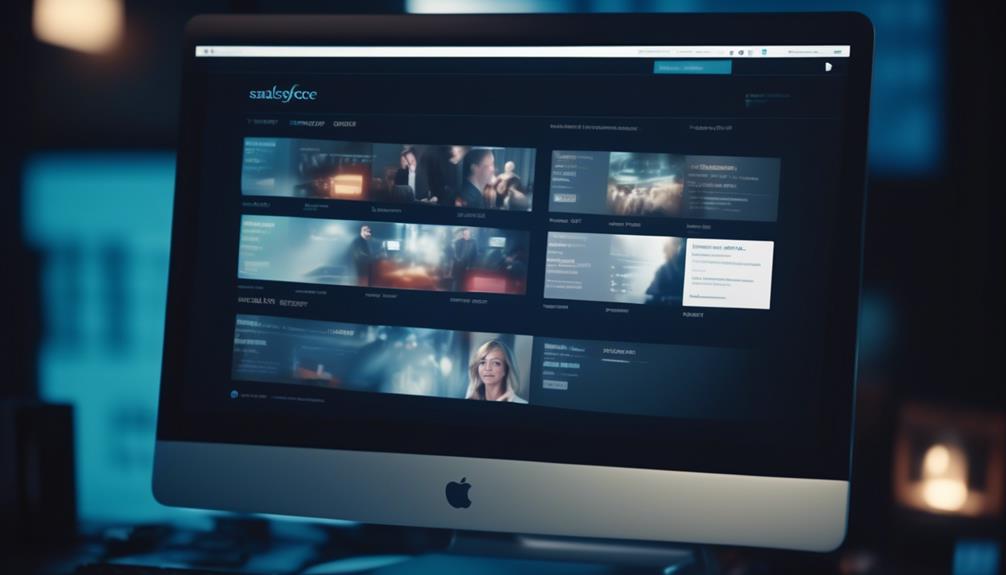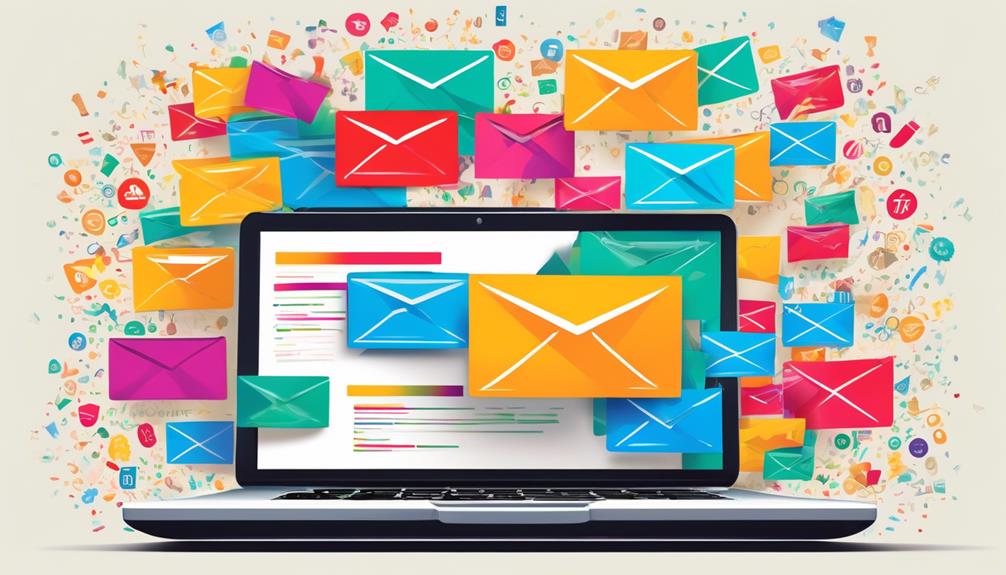In the realm of exploring Salesforce Email Template Examples, it feels akin to searching for a needle in a haystack. We’ve all experienced it: the quest to locate the ideal template that will optimize our email communication.
From Classic Email Templates to Lightning Email Templates, the options can be overwhelming. But fear not, because in this discussion, we'll uncover the ins and outs of each template type, explore their limitations, and learn how to seamlessly switch between Salesforce Lightning and Classic.
Join us as we unravel the intricacies of importing and creating email templates in Salesforce, and discover the benefits of using these templates to streamline your communication efforts.
Key Takeaways
- Classic Email Templates offer customization options for automated emails, including Text, HTML with Classic Letterhead, Custom HTML, and Visualforce templates. They are ideal for automating email alerts and one-to-many communication.
- Lightning Email Templates offer advanced customization and dynamic content options. They use Handlebars Merge Language for merge fields and have a drag-and-drop editor and Enhanced Folders and Sharing options.
- Salesforce Email Templates have limitations such as a limited number of merge fields per template, maximum file size limits for attachments and images, and maximum character limits for template fields. It's important to be aware of these limitations when using email templates.
- Switching between Salesforce Lightning and Classic allows users to leverage distinct functionalities based on their needs. Lightning templates offer dynamic content and responsive designs, while Classic templates support various types including text, HTML, and Visualforce. Understanding the differences allows for effective email communication.
Classic Email Templates
Classic Email Templates offer a range of customization options for creating automated emails with Salesforce. These templates come in various types, including Text, HTML with Classic Letterhead, Custom HTML, and Visualforce templates, allowing for different levels of customization.
When creating Classic Email Templates, users can utilize Contact Fields, Classic Letterheads, and Visualforce components for advanced customization. However, it's important to note that Classic Email Templates have limitations, such as file size constraints, character limits, and formatting restrictions for HTML and CSS elements. Additionally, there are restrictions on merge fields, which may impact the level of personalization that can be achieved.
For users seeking to automate email alerts, send payment requests, or engage in one-to-many communication, Salesforce Classic Email Templates are the ideal choice. These templates provide a streamlined way to create and send standardized emails efficiently.
While Classic Email Templates offer robust features, it's essential to consider the specific needs and limitations when deciding between Classic and Lightning Email Templates.
Lightning Email Templates

Lightning Email Templates offer advanced customization and dynamic content options, providing enhanced features for creating personalized and visually appealing emails in Salesforce. These templates use Handlebars Merge Language for merge fields, allowing for more flexibility in inserting dynamic data into emails. The drag-and-drop editor and Enhanced Folders and Sharing options make creating and managing Lightning Email Templates intuitive and user-friendly.
Additionally, Lightning Email Templates can be easily accessed through the app launcher icon and added as a shortcut to the Salesforce home screen for convenient accessibility.
One notable feature of Lightning Email Templates is the ability to create Enhanced Letterheads with dynamic content and advanced customization options. This enables users to design professional and branded email templates that align with their organization's visual identity. Furthermore, Lightning Email Templates support custom HTML, giving users greater control over the email design and layout.
When using Lightning Email Templates to send emails, the Activity History provides visibility into the email communication, allowing users to track interactions and engagements. Additionally, email alerts can be set up to notify users about specific email activities, ensuring timely follow-ups and responses.
Salesforce Email Template Limitations
Due to the limitations of Salesforce email templates, users may encounter restrictions on the number of merge fields, file sizes for attachments and images, and maximum character limits for various template fields. When using Salesforce email templates, it's essential to be aware of these limitations to ensure that the email templates function as intended. Below is a table summarizing the limitations of Salesforce email templates:
| Limitation | Description |
|---|---|
| Number of merge fields per template | Limited to a specific number per template, depending on the Salesforce.com account and platform. |
| File size for attachments and images | There is a maximum file size limit for attachments and images that can be included in email templates. |
| Maximum character limits for fields | The body, subject line, and other fields in email templates have a maximum character limit. |
| HTML and CSS formatting restrictions | Email templates have restrictions for HTML and CSS elements, limiting customization options. |
Understanding these limitations can help users effectively utilize Salesforce email templates and work within these constraints to create impactful and targeted email communications.
Switching Between Salesforce Lightning and Classic

Understanding the differences between Salesforce Lightning and Classic email templates allows for leveraging distinct functionalities based on specific needs and preferences. When switching between Salesforce Lightning and Classic, users can access different email template functionalities to cater to their requirements.
In the Salesforce platform, Lightning templates offer enhanced features such as dynamic content, rich text, and a drag-and-drop content builder for responsive designs. These templates use Handlebars Merge Language for merge fields, providing greater flexibility for customization.
On the other hand, Salesforce Classic Email Templates support various types including text, HTML with Classic Letterhead, custom HTML, and Visualforce, catering to diverse design and content needs.
When creating email templates, users can take advantage of the capabilities offered by each environment, ensuring that their communication aligns with their branding and content requirements. Whether it's accessing the drag-and-drop content builder in Lightning templates or utilizing specific email alert options in Salesforce Classic, understanding how to switch between the two environments can greatly enhance the effectiveness of email communications.
Importing and Creating Email Templates in Salesforce
When importing and creating email templates in Salesforce, we can utilize various types, such as Classic Email Templates, Text templates, HTML with Classic Letterhead templates, Custom HTML templates, and Visualforce templates to cater to diverse design and content needs.
Here's how we can manage the process:
- Creating New Templates
- Access email templates in Salesforce and select the type of template to create.
- Use HTML code to customize the template to align with brand guidelines and specific content requirements.
- Adding Merge Fields
- Add merge fields to personalize templates with merge field data, ensuring that merge field values dynamically populate based on recipient and custom object information.
Frequently Asked Questions
What Are the 4 Types of Email Templates That Can Be Created in Salesforce?
We can create four types of email templates in Salesforce:
- Text
- HTML with Classic Letterhead
- Custom HTML
- Visualforce templates
Each offers different levels of customization and complexity.
Lightning Email Templates enhance customization with support for dynamic content, merge fields, and the Handlebars Merge Language.
Both Classic and Lightning Email Templates allow for personalization and branding using contact fields, classic letterheads, and drag-and-drop editors.
How Do I Create an Email Template in Salesforce?
Creating an email template in Salesforce involves several steps:
- Navigate to the Email Templates section.
- Select the desired template type.
- Customize the template with merge fields, branding elements, and layout options.
To create responsive designs, we can leverage the drag-and-drop editor in Lightning. In Salesforce Classic, we can use Classic Letterheads.
Moreover, there are various customization options available for both Classic and Lightning Email Templates. These options allow us to create engaging and impactful email communications.
What Is the Email Format for Salesforce?
We use Salesforce email templates, including Classic and Lightning options.
Classic templates offer text, HTML, custom HTML, and Visualforce choices.
Lightning templates have enhanced letterhead, dynamic content, and a drag-and-drop editor.
Both versions have limitations on merge fields, attachment size, and character counts.
In Classic, we select contact fields, customize letterheads, and create custom or Visualforce templates.
In Lightning, we access templates through the app launcher, create enhanced letterheads, and use a drag-and-drop editor for responsive designs.
How Do I Get Classic Email Templates in Salesforce?
We'll guide you through getting classic email templates in Salesforce.
First, navigate to the Email Templates section in Salesforce Classic.
Then, select the type of template you want to create, whether it's text, HTML with Classic Letterhead, custom HTML, or Visualforce.
After that, utilize contact fields for merge fields and test your template to ensure everything looks perfect.
Lastly, consider using Classic Letterheads to add a touch of branding to your templates.
Conclusion
So, while Salesforce email templates offer a world of customization and convenience, it's important to keep in mind the limitations that come with them.
It's like having a shiny new sports car, but only being able to drive it around the block.
We can still make the most of it by carefully navigating around these limitations and utilizing the templates to save time and maintain consistency in our email communications.








